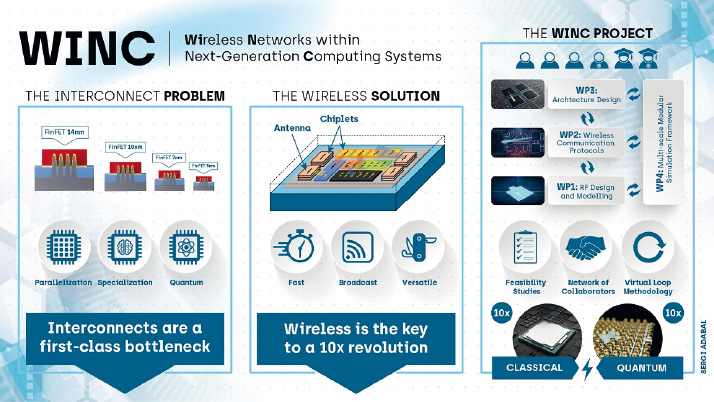A common trait of current computing systems is that their internal data communication has become a fundamental bottleneck. The anticipated death of Moore’s Law has forced computer scientists and architects to find new ways to build faster processors, which include massive parallelization, specialized accelerator design, and disruptive technologies such as quantum computing. These trends cause an exponential increase in the volume and variability of data transfers within computing systems, rendering traditional interconnects insufficient and threatening to halt progress unless fast and versatile communication alternatives are developed.
In this context, the WINC project envisions a revolution in computer architecture enabled by the integration of wireless networks within computing systems. The main hypothesis is that wireless terahertz technology will lead to at least a tenfold improvement in the speed, efficiency, and scalability of both non-quantum and quantum systems. With a cross-cutting approach, WINC aims to validate the hypothesis by (i) revealing the fundamental limits of wireless communications within computing packages, (ii) developing antennas and protocols that operate close to those limits while complying with the stringent constraints of the scenario, and (iii) developing radically novel architectures that translate the unique benefits of the wireless vision into order-of-magnitude improvements at the system level. If successful, WINC will be the seed of a new generation of non-quantum and quantum systems and foster progress in the computing field for the decades to come.


Website:
Project Type:
Funding:
Duration:
Website:
Project Type:
Funding:
Duration:
A common trait of current computing systems is that their internal data communication has become a fundamental bottleneck. The anticipated death of Moore’s Law has forced computer scientists and architects to find new ways to build faster processors, which include massive parallelization, specialized accelerator design, and disruptive technologies such as quantum computing. These trends cause an exponential increase in the volume and variability of data transfers within computing systems, rendering traditional interconnects insufficient and threatening to halt progress unless fast and versatile communication alternatives are developed.
In this context, the WINC project envisions a revolution in computer architecture enabled by the integration of wireless networks within computing systems. The main hypothesis is that wireless terahertz technology will lead to at least a tenfold improvement in the speed, efficiency, and scalability of both non-quantum and quantum systems. With a cross-cutting approach, WINC aims to validate the hypothesis by (i) revealing the fundamental limits of wireless communications within computing packages, (ii) developing antennas and protocols that operate close to those limits while complying with the stringent constraints of the scenario, and (iii) developing radically novel architectures that translate the unique benefits of the wireless vision into order-of-magnitude improvements at the system level. If successful, WINC will be the seed of a new generation of non-quantum and quantum systems and foster progress in the computing field for the decades to come.

